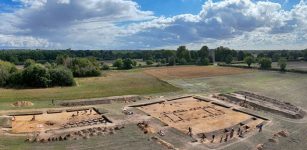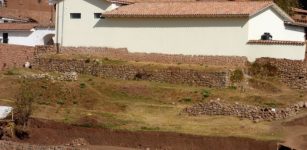Ancient Secrets Of Dougong Brackets: How 2,500-Year-Old Buildings Could Survive Earthquakes
Ellen Lloyd - AncientPages.com - There is still much to be learned from our ancestors who were familiar with several types of advanced technologies.
Dougong brackets were used a very long time ago to construct buildings that could survive earthquakes.
About 2,500 years ago, ancient people designed and engineered a solution that prevented buildings from falling apart during earthquakes. The ancient builders created a series of brackets known as dougong.
Various types of dougong brackets.
The earliest evidence of dougong brackets comes from China and dates to 1100 B.C. Ancient builders in Persia and India were also familiar with dougong brackets in their simplest form. A bracket set is a group of wood blocks (dou) and short beam-arms (gong) cut so they interlock and form a unit when stacked up together.
Timber traditionally comprises the main structure in Chinese architecture, while walls, doors, and windows are not load-bearing, sometimes made of latticework, mud or other delicate material.
Colorful dougong supporting a structure at Sagami-ji, Japan. Image credit: 663highland
In such a timber structure, with columns as the lower part and beams as the upper part, a middle part between columns and beams which helps eaves stretching out is extremely important. This is the special part of dougong, a unique structural element of interlocking wooden brackets. Interlocking bracket sets are formed by placing a large wooden block (dou) on a column to provide a solid base for the bow-shaped brackets (gong) that support the beam or another gong above it.
Ancient scientists discovered that when dougong brackets were interlocked together could transfer the incredibly heavyweight of a temple roof to the supporting columns, and they contained so many redundancies that they could not be shaken apart.
When interlocked together, these could transfer the incredibly heavyweight of a temple roof to the supporting columns, and they contained so many redundancies that they could not be shaken apart. Dougong brackets were a superb solution because they connected with friction and gravity.
According to Richard S. Wiborg who has studied ancient Chinese and Japanese architecture “From 200 B.C. to 600 A.D., Chinese builder-architects adapted brackets to function perpendicular to the wall-plane as cantilever beams. They sometimes added a cross-yoke onto a perpendicular arm.
Now a bracket set could support a wall and a small roof eave. At this point, the bracket set became a three-dimensional cluster of parts.
During the Tang, Liao, and Sung dynasties (600-1200 A.D.), the art of bracketing reached its zenith. Builders wanted to erect bigger structures. They enlarged the elements (columns, beams, rafters) while preserving the same proportions. The basic building format, i.e., a rectangular plan wider than deep enclosing a single space, did not change. The roof and roof-overhang (eaves) needed to be proportionally larger, though.
See also:
What Did Houses For Ordinary People In Sumer Look Like?
Herostratic Fame Relates To Herostratus Who Burned The Beautiful Temple Of Artemis To Become Famous
Builders had to figure out how to construct a wider eave. So they invented a larger bracket system that could cantilever farther out from the wall-plane and they added a new structural member—the eave-purlin—to carry rafters beyond the wall purlin.”
Dougong brackets solved four problems that arise as buildings get bigger. They helped architects to reduce beam spans, to brace wall sections above columns, how to support a wide eave, and to strengthen the frame.
By spreading the dougong brackets’ tolerances over multiple joints, builders could achieve a measure of flexibility that prevented the brackets from cracking and splitting. In regions where earthquakes occurred frequently, the use of dougong brackets saved many lives and money.
It’s truly remarkable to see that more than 2,000 years ago, ancient people knew how to construct timber building that could withstand devastating earthquakes.
While ancient Chinese used dougong brackets to keep their buildings from falling apart, ancient Romans discovered a way to construct piers that survived continuous battering of the ocean waves for more than 2,000 years.
Modern concrete seawalls embedded with steel crumble within decades, but ancient water-based structures became stronger over time. Scientists may have solved the mystery of ancient Roman concrete that still stands strong.
Written by Ellen Lloyd – AncientPages.com
Copyright © AncientPages.com All rights reserved. This material may not be published, broadcast, rewritten or redistributed in whole or part without the express written permission of AncientPages.com
Expand for referencesMore From Ancient Pages
-
 Altai Mountains Were Home To Porcupines 30,000 Years Ago
Archaeology | Mar 14, 2017
Altai Mountains Were Home To Porcupines 30,000 Years Ago
Archaeology | Mar 14, 2017 -
 Ancestral Puebloans Survived Devastating Climate Change Hiding In New Mexico Lava Tubes
Archaeology | Nov 20, 2020
Ancestral Puebloans Survived Devastating Climate Change Hiding In New Mexico Lava Tubes
Archaeology | Nov 20, 2020 -
 Glooskap (Gluskap): Mythical Hero Who Defeated Evil Sorcerers And Demon Followers
Featured Stories | Jan 25, 2016
Glooskap (Gluskap): Mythical Hero Who Defeated Evil Sorcerers And Demon Followers
Featured Stories | Jan 25, 2016 -
 Vedic God Indra: Ruler Of Heavens And Tough Warrior Who Kills Evil Serpent Vritra
Featured Stories | Feb 1, 2019
Vedic God Indra: Ruler Of Heavens And Tough Warrior Who Kills Evil Serpent Vritra
Featured Stories | Feb 1, 2019 -
 Evidence Of An Unknown Ancient Civilization In The Yucatan?
Featured Stories | Apr 6, 2024
Evidence Of An Unknown Ancient Civilization In The Yucatan?
Featured Stories | Apr 6, 2024 -
 Vikings Cared Deeply For Their Animal Companions – Shared Human And Horse Burials Reveal
Featured Stories | Aug 3, 2023
Vikings Cared Deeply For Their Animal Companions – Shared Human And Horse Burials Reveal
Featured Stories | Aug 3, 2023 -
 Scientists Reconstruct The Climate Of The Ancient World Using Small Wooden Artifacts And Mummies
Archaeology | Apr 5, 2023
Scientists Reconstruct The Climate Of The Ancient World Using Small Wooden Artifacts And Mummies
Archaeology | Apr 5, 2023 -
 4,500-Year-Old Skeletons Found In SW China
Archaeology | Apr 19, 2016
4,500-Year-Old Skeletons Found In SW China
Archaeology | Apr 19, 2016 -
 Glima – Ancient Martial Art Practiced By The Vikings Is Still Popular Today
Ancient Traditions And Customs | Mar 7, 2017
Glima – Ancient Martial Art Practiced By The Vikings Is Still Popular Today
Ancient Traditions And Customs | Mar 7, 2017 -
 Older Than Dracula: In Search Of The English Vampire
Myths & Legends | Dec 9, 2022
Older Than Dracula: In Search Of The English Vampire
Myths & Legends | Dec 9, 2022 -
 World’s First ‘Cash Machine’ Discovered In A Wall Of An Ancient Bakery
Archaeology | Apr 1, 2022
World’s First ‘Cash Machine’ Discovered In A Wall Of An Ancient Bakery
Archaeology | Apr 1, 2022 -
 Italy’s Stunning Secret Temples Of Damanhur – City Of Light
Featured Stories | May 21, 2017
Italy’s Stunning Secret Temples Of Damanhur – City Of Light
Featured Stories | May 21, 2017 -
 4,000-Year-Old Babylonian Tablets Finally Deciphered, Revealing Dangerous Future Predictions
Archaeology | Aug 14, 2024
4,000-Year-Old Babylonian Tablets Finally Deciphered, Revealing Dangerous Future Predictions
Archaeology | Aug 14, 2024 -
 Ship-Shaped Burial Of Tjelvar – Legendary First Man Who Brought Fire To Gotland
Featured Stories | Feb 25, 2021
Ship-Shaped Burial Of Tjelvar – Legendary First Man Who Brought Fire To Gotland
Featured Stories | Feb 25, 2021 -
 The Invisible Plant Technology Of The Prehistoric Philippines
Archaeology | Jul 1, 2023
The Invisible Plant Technology Of The Prehistoric Philippines
Archaeology | Jul 1, 2023 -
 Huge 1,400-Year-Old Hall Of The First Kings Of East Anglia Discovered In Rendlesham
Archaeology | Oct 5, 2022
Huge 1,400-Year-Old Hall Of The First Kings Of East Anglia Discovered In Rendlesham
Archaeology | Oct 5, 2022 -
 Lost Ancient Greco-Bactrian Kingdom Of 1,000 Cities
Civilizations | Apr 23, 2016
Lost Ancient Greco-Bactrian Kingdom Of 1,000 Cities
Civilizations | Apr 23, 2016 -
 Impressive Inca Agricultural Terraces Discovered In Cusco, Peru
Archaeology | Jan 25, 2018
Impressive Inca Agricultural Terraces Discovered In Cusco, Peru
Archaeology | Jan 25, 2018 -
 Meidum ‘Collapsed’ Pyramid Of Great Builder Pharaoh Snefru
Featured Stories | Jan 2, 2017
Meidum ‘Collapsed’ Pyramid Of Great Builder Pharaoh Snefru
Featured Stories | Jan 2, 2017 -
 4000-Year-Old Egyptian Leather Manuscript Forgotten For More Than 70 Years – Found
News | Sep 14, 2015
4000-Year-Old Egyptian Leather Manuscript Forgotten For More Than 70 Years – Found
News | Sep 14, 2015




